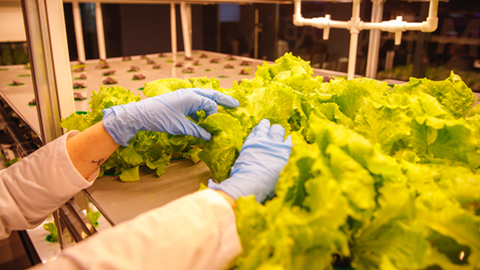Siberian Federal University Scientists Use Low-Cost Vertical Farms To Harvest Microgreens
Scientists of Siberian Federal University have offered ways to improve the technology of growing various crops in hydroponic vertical farms. Software has been developed to help carry out continuous monitoring of plant life in a city farm, as well as a neural network responsible for detecting poor-quality seeds and seedlings. The development will significantly reduce the cost of growing microgreens, aromatic herbs, lettuce and vegetables for both restaurant holdings and private farms.
The experts engineered several programs — one of them is responsible for maintaining the parameters of the hydroponic installation that are comfortable for plants by adjusting the balance of salts; the other one monitors the acidity of the solution feeding the greens in the installation. General control over the seed material is carried out by a smart neural network which detects low-quality sprouts to be removed.
“Our neural network is able to control the quality of plants – to track and discard weak and diseased sprouts in order to minimize the rejection of finished products. The hardware implementation of the neural network is made on a chip, which speeds up all calculations several times. The same calculations on a computer would take more time,” said Anton Khantimirov, author and software developer, senior lecturer at the Department of Computer Science of SibFU, employee of the interdisciplinary city-farming laboratory of the Gastronomy R&D Park of SibFU.
The scientists advocate that such automation of the process significantly saves time for employees — there is no need to take measurements manually anymore, the programs independently monitor the balance of acids and salts, injecting the missing components from two prepared solutions into the hydroponic installation.
“The program measures the electrical conductivity of the solution that feeds the plants and adds salts of potassium, nitrogen, and so on, if necessary, the water-salt balance is monitored in this way. A special microcontroller, if necessary, starts pumps that pump in salts or acidify the nutrient solution in the installation”, the scientist continued.
Network monitoring is good because researchers can track the well-being of their green charges over long distances. For example, using a special application installed on a smartphone, laboratory employees receive a report every morning with graphs that show the basic indicators of humidity, acidity, and illumination of plants. One can monitor the status of a hydroponic installation from home or a business trip, and even while on the road. The demo version involves only monitoring, but in a couple of months the employees of SibFU’s city farm will be able to remotely influence the indicators of hydroponic installations through the application, this will reliably protect the crop from death in force majeure situations.
“We successfully grow microgreens, aromatic herbs (various varieties of basil), several varieties of lettuce. Vegetables are next in turn, first of all – tomatoes. The beauty of urban vertical farms is that products, being fresh and with the right balance of nutrients and vitamins, almost immediately, without long transportation and associated logistics costs, go to restaurants and shops, or directly to consumers. For example, greens grown by us are used in less than an hour, after they were collected, at Истории student restaurant which is both a gourmet restaurant open to all guests and a training laboratory for student projects of the School of Gastronomy of Siberian Federal University. Also, restaurants of Bellini Group, the largest Krasnoyarsk holding, are consumers of our products,” said Anton Khantimirov.
An installation for growing vegetables using hydroponics is currently involved in another experiment — SibFU scientists use special phosphors to change lighting characteristics quickly, which allows you to choose the optimal conditions for plants. It is known, for example, that blue lighting makes plants stockier, not allowing them to stretch excessively in height, and red lighting helps fruit ripen.
An important advantage of hydroponic installations with software developed at SibFU is their low cost, which makes them much more profitable than analogues available in the market. In addition, such city farm can be almost entirely equipped with domestically produced parts made as a part of an import substitution strategy.

